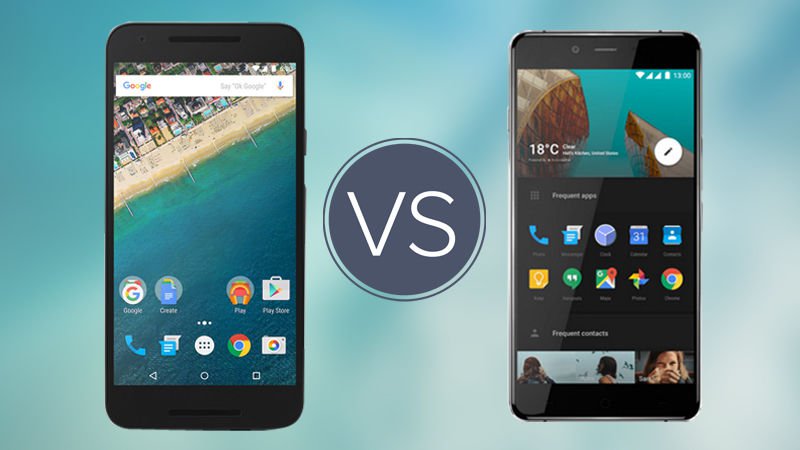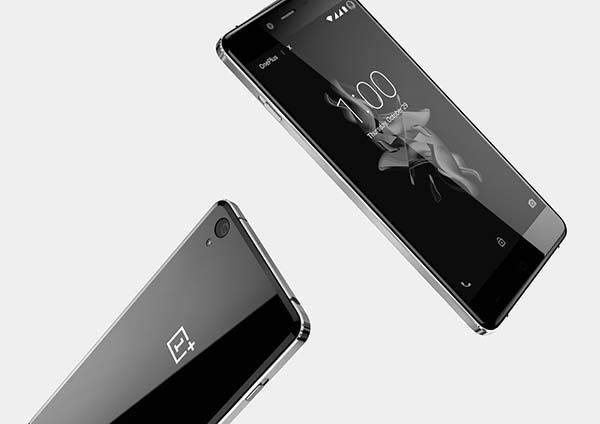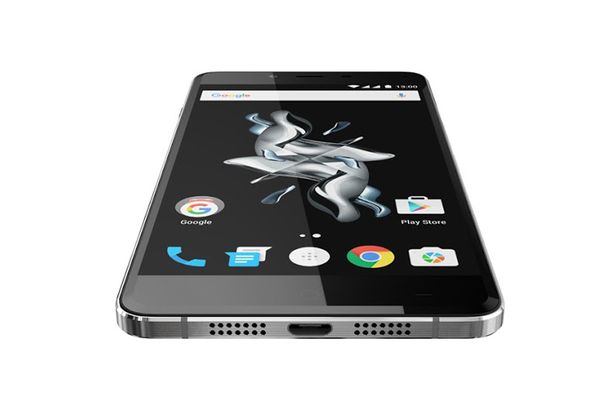OnePlus X and Nexus 5x are just two of the many flagship and mid-range phones that marked this fall. The most anticipated smartphones of this year, in my opinion, were the Nexus 5x and Nexus 6p. Among the more famous brands that launched a new device there are also less known manufacturers, the underdogs who work hard at making a name for themselves.
OnePlus X
OnePlus is one of these underdogs, a small Chineze brand that stated making a name for itself by making smartphones with flagships specs with budget price tags. The OnePlus X tries to fit in the category of phones that trade off screen size, battery and high-end hardware for a more comfortable single hand use.
The OnePlus X looks great, definitely more expensive than it actually is. It has a 5″screen, a metal frame build and a glass back. The dimensions are made well balanced for single hand use, it’s 140x69mm and just 6,9 mm thick. The metal frame that goes around the device has several microcuts ( parallel lines that go around the frame). These microcuts helps to grip the device better, as the glass back is more slippery than other materials.
On the right side we have a SIM slot. The device is dual SIM, but the SIM tray can fit a Micro-SD card instead of the second SIM. Under the SIM slot there is a volume rocker and the power button. On the left side there is a notifications button, similar to what we see on the OnePlus 2. These buttons have a nice feel and a good feedback when pressed. The bottom features a Micro-USB port and 2 speaker grills, but only one speaker.
The 5- inch display of the OnePlus X is an AMOLED display, the first used by OnePlus. It has Full HD resolution, 441 ppi pixel density and OnePlus X is protected by Corning Gorilla Glass 3 which makes it more durable. The images produced by the screen of the OnePlus X are clear, crisp and accurate, so users definitely don’t have to make a compromise when it comes to the display of the OnePlus X.
OnePlus X is powered by the Snapdragon 801 with a quad- core processor clocked at 2.3 GHz. This is paired with an Adreno 330 GPU. The OnePlus X comes in two versions. The lower capacity one includes 2 GB of RAM and 16 GB internal storage, while the more powerful includes 3 GB of RAM and 16 GB internal storage.
The cameras of the OnePlus X are also great and comparable to those of high- end devices. The back camera has a 13 MP sensor that will deliver 4128 x 3096 pixels resolution pictures. The camera also has phase detection autofocus, LED flash and features geo- tagging, touch focus, face detection, panorama mode and HDR. It records 1080 p videos at 30 fps or 720 p videos at 120 fps. The secondary camera of the OnePlus X has a 8 MP sensor which is actually better than that featured by many of the recently launched expensive smartphones out there.
The OnePlus X has a 2450 mAH non- removable battery. This will be able to ensure a day’s worth of battery life for sure. It’s not the highest- capacity battery on the market, but it isn’t the weakest one either.
KEY SPECS
- CPU – Quad-core 2.3 GHz/Qualcomm Snapdragon 801
- GPU – Adreno 330
- DISPLAY –Corning Gorilla Glass 3, 5 inches, AMOLED capacitive touchscreen, 16M colors, 1080 x 1920 pixels (~441 ppi pixel density)
- MEMORY – 16 GB, 2/3 GB RAM; microSD, up to 128 GB (uses SIM 2 slot)
- BATTERY – Non-removable Li-Po 2525 mAh battery
- CAMERA –13 MP, 4128 x 3096 pixels, phase detection autofocus, LED flash;Secondary camera 8 MP
- VIDEO – 1080p@30fps, 720p@120fps
- BODY – 140 x 69 x 6.9 mm (5.51 x 2.72 x 0.27 in)
- WEIGHT – 138 g / 160 g (4.87 oz)
- WIRELESS – Wi-Fi 802.11 b/g/n, hotspot
NEXUS 5x
Nexus 5x is Google’s smaller mobile device made by LG. Google didn’t neglect the users who want a single hand device. Some people were worried when the Nexus 6 from Motorola was launched that it would bring the end of Nexus phones that would fit and be operated with one hand. Luckily Google understands the importance of a smaller devices and this year launched 2 smartphone, the Nexus 5x with a 5.2 inch display and a phablet with a 5.7 inch display. This way Google made all their fans happy by upgrading 2 different size devices at the same time.
The Nexus 5x looks similar to the Nexus 6 from the front. I has 2 speakers, one at the top and the other at the bottom, the phone is flat on each side, not curved at the top and bottom like the previous version. It has the volume rocker on the right side, under the lock key. The back of the Nexus 5x features a camera with LED flash, under it there is a fingerprint sensor, the Nexus logo and at the bottom the LG logo.
Overall the exterior of the device looks decent, maybe it’s just because of the colors, Quartz White, Carbon Black and Ice Blue, but the plastic back looks a bit cheap and brittle. The previous version looked and felt more rugged and seemed like they used premium materials. The nexus 5x is a powerful contrast to the 6P which has a solid metal frame.
Nexus 5x comes with a 5.2 inch display that has a 1080 x 1920 (full HD) resolution and a pixel density of 424 ppi. It’s screen to body ratio is 69.8%. To protect the touchscreen the display is covered in Corning Gorilla Glass 3. On the inside this smartphone is equipped with high-end components.
It’s powered by the Snapdragon 808, a quad-core 1.44 GHz Cortex-A53 and dual-core 1.82 GHz Cortex-A57. The camera received a noticeable upgrade, the main one has a 12 MP sensor, with laser auto-focus, dual tone LED flash. The Nexus 5x also features a secondary front facing camera that has a 5MP sensor. There are also a bunch of sensors that are used by different apps accelerometer, gyroscope, barometer and so on.
To keep the device running more, Google asked for 2700 mAh non-removable Li-Po battery. This battery should have no problem of keeping the Nexus 5x powered on for at least 2 full days of mixed use.
As big positive features, the Nexus 5x comes with the brand new Android OS, 6.0 Marshmallow. Even though other Android devices will receive an upgrade to Android M the Os will probably not run as smooth as it does on Nexus. This is one of the biggest advantages of having a Google device. Another novelty is the USB type C connection, Nexus being among the first smartphones to feature this type of connection.
KEY SPECS
- DISPLAY: 5.2″ screen, with a 1080×1920 resolution and has 424 ppi.
- CHIPSET: Qualcomm MSM8992 Snapdragon 808 with a quad-core 1.44 GHz Cortex-A53 and a dual-core 1.82 GHz Cortex-A57. It uses the Adreno 418 GPU.
- MEMORY: 2 GB of RAM and 16/32 Internal storage. No external memory support.
- CAMERA: a main 12.3 MP, laser autofocus, dual-LED (dual tone) flash, with a 1.55µm pixel size to catch more light; a secondary front 5 MP camera
- CONNECTIVITY: Wi-Fi, DLNA, hotspot, Bluetooth 4.2, GPS, NFC, USB Type-C
- SENSORS: Accelerometer, gyro, proximity, compass, barometer
- BATTERY: Non-removable Li-Po 2700 mAh battery
Both devices have a lot of pros and cons on their sides. Overall I have to say that the OnePlus X has more pros then the Nexus 5x. It looks amazing, giving a feel of quality, a lot more than what the price tag would suggest. The Nexus 5x has a few features that are rare at the moment. The fingerprint sensor is not ground breaking, but the placing on the back is a very smart move. This way you unlock the phone while you’re lifting it and by the time you look at the screen it’s ready to go. USB Type-C is one of those hardware features that isn’t found on many devices and offers greater transfer and charging speeds.
The biggest pro on the Nexus side is the pure Android OS and being the first to get Google’s updates. At the end when you draw the line these few pros may not tilt the scales enough. The OnePlus X costs 200$ less and has a more elegant design with more memory and external memory support.
 Tech Gadget Central Latest Tech News and Reviews
Tech Gadget Central Latest Tech News and Reviews







